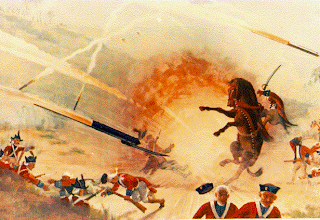

Dr Kalam, considered father of Indian missile programme, says that when Tipu Sultan was killed, the Britishers captured more than 700 rockets and sub-systems of 900 rockets in the battle of Turukhanahally in 1799.
In his autobiography "Wings of Fire" which is selling like hot cakes since he was nominated for the post of the President, Dr Kalam, who is a Bharat Ratna, says: "Tipu's army had 27 brigades, called Kushoons, and each brigade had a company of rocketmen called Jourks." Showering praise on Tipu Sultan, he said that these rockets were taken to England by William Congreve and were subjected to what we call "reverse engineering" today.
"There was of course no GATT, no IPR Act or patent regime... With the death of Tipu, the Indian rocketry also met its demise -- at least for 150 years," he writes. He also points out that Tipu Sultan was also revered in the US and recalls his experiences at NASA. When he went to the Wallops Flight Facility at Wallops Islands in East Coast, Virginia, which was a base of NASA's sounding rocket programme, he saw a painting displayed prominently in the lobby there. But what was it? It depicted a battle scene with rockets flying in the background.
"A painting with this theme should be the most common place thing at a flight facility, but the painting caught my eye because the soldiers on the side launching the rockets were not white, but dark-skinned, with the racial features of people found in South Asia," he says.
"One day," Dr Kalam, the President-in-waiting writes, "My curiosity got the better of me, drawing towards the painting. It turned out to be Tipu Sultan's army fighting the British. "The painting depicted a fact forgotten in Tipu's own country but commemorated here on the other side of the planet. I was happy to see an Indian glorified by NASA as a hero of warfare rocketry," he recalls. Historians mention that rockets helped the Mysore army to achieve the famous victory over the Britishers in 1780. The army was led by Hyder Ali, the bold officer and his son Tipu. A celebrated victim of the rocket attack was Colonel Arthur Wellesley (later Duke of Wellington and hero of Waterloo).
In the fourth Anglo-Mysore war of 1799, Wellesley had a nasty encounter in a mango grove just outside Srirangapatna. He lost his way, several of his men killed and the rest retreated in disorder. Historians also point out that the Rocket Corps of Mysore army was 5,000 strong in Tipu's time. Historians say that his rocketmen were skilled in adjusting the elevation of the rocket depending on its distance from the target and they launched rockets rapidly.
Tipu Sultan was a technology buff and promoted the manufacture of rockets and other novel devices in his territories. The rockets' range was typically 2.4 km, an outstanding performance of its time, attributable to the iron and the casing. Indian iron and steel had been the best in the world and permitted increased bursting pressures with their propellant packing, the chroniclers have noted.



 Congreve rocket
Congreve rocket


